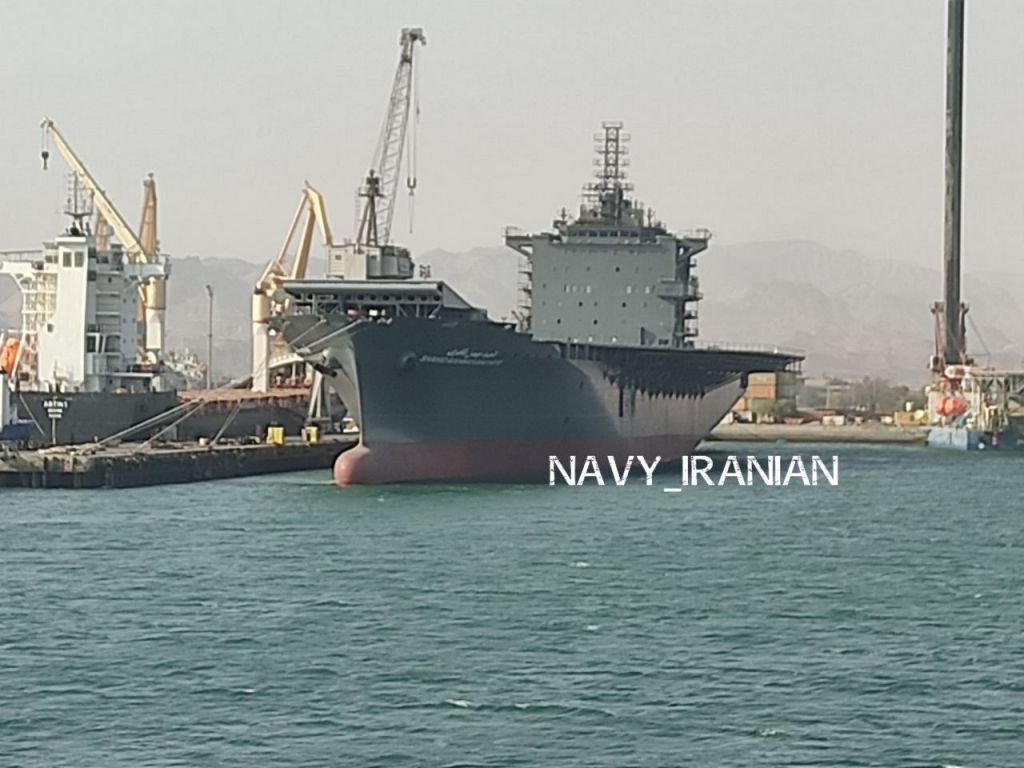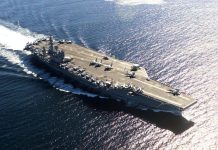A recently revealed image provides a glimpse of what is expected to be “Iran’s first aircraft carrier,” the IRGC Shahid Bagheri, highlighting its unique design and the current advancements in its construction.
The ship, referred to as a “forward base ship,” signifies a significant advancement in Iran’s naval aspirations. It is especially highlighted by its unique angled flight deck and a ‘ski-jump’ ramp designed for aircraft launches, which are prominently displayed in the latest image.
The Shahid Bagheri is not an entirely new build but a conversion of the 24-year-old container ship, Perarin. The vessel is being repurposed for the Iranian Revolutionary Guards Corps (IRGC), the paramilitary force overseeing naval activities in the inner Persian Gulf.
The Shahid Bagheri’s design, which utilizes the container ship’s 790-foot length to accommodate a flight deck, has led some to label it “Iran’s first aircraft carrier”.
However, this claim has been met with skepticism, with critics pointing out that the ship’s capabilities and design differ significantly from traditional aircraft carriers.
تصویری از ناو پهپاد بر باقری pic.twitter.com/oBx5Y1JRjV
— Iranian Naval Force (@Navy_Iranian) August 20, 2024
Nonetheless, the conversion is being carried out by the Iran Shipbuilding & Offshore Industries Complex Company (ISOICO) near Bandar Abbas. The work reportedly began in May 2022 when the ship was first observed in a dry dock.
The project aligns with a wider trend in Iran’s naval strategy, in which commercial vessels that have become unfit for trade—primarily due to international sanctions—are being repurposed as military assets.
The approach is reminiscent of the US Navy’s expeditionary sea base model. The IRGCN, in collaboration with the Iranian Navy, has utilized this strategy to expand its operational capabilities, including the execution of global presence missions.
ISOICO has prior experience with such conversions. The company previously transformed an oil tanker into the Iranian Navy’s Makran, another forward base ship with a smaller flight deck designed for helicopter and drone operations.

Another notable example of this trend is the IRGC Shahid Roudaki, a former commercial vessel converted into an “oceangoing warship capable of carrying aircraft.”
The exact timeline for Shahid Bagheri’s entry into service remains uncertain. The continued development of these aviation-capable ships highlights Iran’s evolving naval capabilities and its ongoing efforts to project power across regional and global waters.
A Symbolic Step In Naval Innovation
As Iran’s military grapples with decades of sanctions and limited resources, the Shahid Bagheri stands out as a symbol of innovation and ambition despite its unconventional nature and the uncertainties surrounding its capabilities.
Although the vessel is sometimes labeled as an aircraft carrier, its primary function is more accurately described as a drone carrier ship. It may carry some manned aircraft like helicopters.
Yet, its design and purpose are specifically tailored to support and deploy a range of drones, making its core role distinct from that of a traditional aircraft carrier.
The vessel is aimed to support Iran’s growing arsenal of locally-produced drones and aging helicopters, many of which date back to the 1970s when Iran was under the rule of the Shah.
The vessel’s roughly 790-foot length provides space for these assets, though its true operational role remains unclear. While the Shahid Bagheri is unlikely to pose a direct threat to the US Navy or its allies, it carries significant symbolic value.

Its potential to launch and operate Iran’s diverse drone fleet—including medium-altitude, long-endurance drones and VTOL (Vertical Take-Off and Landing) models—could extend Iran’s reach and influence, particularly towards its regional adversaries.
The possibility of integrating jet-powered, high-performance drones further complicates the vessel’s role. These drones could improve the carrier’s functionality by allowing it to deploy heavier and longer-range drones, including one-way attack variants, thereby offering a strategic edge.
Iran’s influence in the armed drone sector is growing, with models like the Mohajer-6, Shahed-129, Shahed-131, and Shahed-136 kamikaze drones. These drones have already demonstrated their effectiveness in conflicts, including the war between Russia and Ukraine, where they have been used to target Ukrainian infrastructure.
Meanwhile, several questions remain about Shahid Bagheri’s practical utility. The ship retains its original superstructure, which spans the entire width of the deck, complicating the use of a conventional flight deck configuration.
The angled deck, which extends to the bow ramp, introduces challenges for aircraft recovery and launch. The proximity of the superstructure to the angled deck area raises concerns about potential collisions during recovery operations.
Additionally, the vessel’s ability to handle various types of aircraft, including the use of arresting wires or barrier recovery systems, is still uncertain.
The dimensions and design constraints suggest that any aircraft attempting to land on the Shahid Bagheri could face difficulties, particularly if they do not come to a complete stop after touching down.
- Contact the author at ashishmichel(at)gmail.com
- Follow EurAsian Times on Google News




